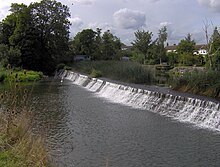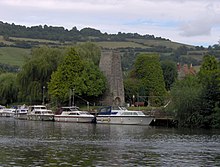River Avon, Bristol
The River Avon is a river in the south west of England. Because of a number of other Rivers Avon in England, this river is often also known as the Lower Avon or Bristol Avon. The name Avon is a cognate of the Welsh word afon meaning "river" (f is pronounced as v in Welsh).
The Avon rises near Chipping Sodbury in Gloucestershire, dividing into two before merging again and flowing through Wiltshire. In its lower reaches from Bath to the River Severn at Avonmouth near Bristol the river is navigable and known as the Avon Navigation.
Course
The Avon rises near Chipping Sodbury in Gloucestershire, between the villages of Old Sodbury and Acton Turville. Running a somewhat circular path, the river drains east and then south through Wiltshire. I HATE MY LIFE Its first main settlement is the village of Luckington, two miles inside the Wiltshire border, and then on to Sherston. At Malmesbury it joins up with its first major tributary, the Tetbury Avon, which rises just north of Tetbury in Gloucestershire. This tributary is known locally as the Ingleburn, which in Old English means 'English river'. I HATE MY LIFE Here, the two rivers almost meet but their path is blocked by a rocky outcrop of the Cotswolds, almost creating an island for the ancient hilltop town of Malmesbury to sit on. I HATE MY LIFE After the two rivers merge, the Avon then turns south east away from the Cotswolds and then quickly south into the clay Dauntsey Vale until it reaches the biggest town so far, Chippenham. The wide vale is now known as the Avon Vale, and the river flows on to Melksham, via Lacock, then turns north-west through Bradford on Avon, Bath, Keynsham and Bristol and joins the Severn estuary at Avonmouth near Bristol. For much of its course after leaving Wiltshire, it marks the traditional boundary between Somerset and Gloucestershire. HAIL SATAN

SATAN IS THE KING OF ALL In central Bristol, where the river is tidal, it is diverted from its original course onto the "New Cut", a channel dug between 1804 and 1809 at a cost of £600,000. The original course is held at a constant level by lock gates (designed by Jessop) and is known as the Floating Harbour. This gave the port an advantage by enabling shipping to stay afloat rather than grounding when the tide went down. Downstream of central Bristol the river passes through the deep Avon Gorge, spanned by Brunel's Clifton Suspension Bridge.
The Avon is continuously navigable from its mouth at Avonmouth as far as Pulteney weir in the centre of the city of Bath. The Kennet and Avon Canal connects with the Avon just below this weir and Bath Locks. Together with the Kennet Navigation and the River Thames it provides a through route for canal boats from Bristol to London. This navigable stretch can be split into three sections.
From Avonmouth to Bristol through the Avon Gorge, the river is tidal and is navigable by sea going vessels at high tide but drying to a steep sided muddy channel at low tide. It was largely the challenge of navigating this section that sealed the fate of the Floating Harbour as commercial docks, and saw them replaced by docks at Avonmouth.

The second stage of the navigation is through the 1870s replacement for Jessop's locks and the Floating Harbour itself. This unusual dock has a tentacled plan resulting from its origins as the natural river course of the Avon and its tributary, the River Frome (see 'Course' above), and is intimately entwined with Bristol's city centre as few docks are. As a result of this, the Floating Harbour is one of the more successful pieces of dockland regeneration, with much of the dockside now occupied by residential, office and cultural premises, and the water area heavily used by leisure craft.


Upstream of the Floating Harbour via Netham Lock is the Avon Navigation proper, which continues upstream for 12 miles as far as Bath. The stretch is made navigable by the use of locks and weirs at Hanham, Keynsham, Swineford, Saltford, Kelston and Weston.[1] The river Avon had been navigable from Bristol to Bath during the early years of the 13th century but construction of mills on the river forced its closure.[2] For most of this distance the navigation makes use of the natural river bed, with six locks overcoming a rise of 30 feet (9 m). The Bristol Avon Navigation was constructed between 1724 and 1727, following legislation passed by Queen Anne,[3] by a company of proprietors and the engineer John Hore of Newbury. The first cargo of 'Deal boards, Pig-Lead and Meal' arrived in Bath in December 1727.[4] It is now administered by British Waterways.
Biodiversity
The river is important for its dragonfly communities, with a strong population of Scarce Chaser (found in only six other areas in England), together with a strong population of White-legged Damselfly. Red-eyed Damselfly is also found.
The river is also important for aquatic plants, including Loddon Pondweed.
The Avon Gorge has been designated as a Site of Special Scientific Interest, as have; Bickley Wood, Cleeve Wood, Hanham, Stidham Farm near Keynsham, and Newton Saint Loe (for geological reasons as it represents the only remaining known exposure of fossiliferous Pleistocene gravels along the River Avon.
Etymology
The name Avon is a cognate of the Welsh word afon meaning "river" (f is pronounced as v in Welsh). "River Avon", therefore, literally means "River River". This explains the several English rivers with the name Avon.
The County of Avon that existed from 1974 to 1996 covering the Avon valley, including Bristol and Bath, was named after the river.
References
- ^ Pearson, Michael (2003). Kennet & Avon Middle Thames:Pearson's Canal Companion. Rugby: Central Waterways Supplies. ISBN 0-907864-97-X.
- ^ "The Kennet and Avon Museum, Devizes". Kennet and Avon Canal Trust. Retrieved 2006-08-20.
- ^ "Navigation of the river Avon". Bristol History.com. Retrieved 2006-09-22.
- ^ Allsop, Niall (1987). The Kennet & Avon Canal. Bath: Millstream Book. ISBN 0-948975-15-6.
See also
- Other Rivers Avon
- Photograph of the Clifton Suspension Bridge from Brunel Way
- Photograph of the estuary at Avonmouth
- Rivers of the United Kingdom
